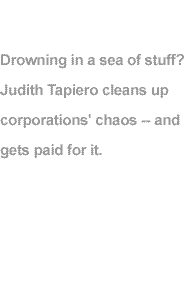 |
|
||||||||||||

|

|
|
By Kathy Spring
|
Judith Tapiero isn't your average librarian. After all, her clients aren't runny-nosed three-year-olds demanding to hear Where the Wild Things Are at story time. They're big corporations and organizations, like the U.S. Golf Association (U.S.G.A.), the American Council on the Arts, and the Boston Consulting Group. These groups, along with the 150 other associations, companies, and individuals she's worked with, don't need a librarian to "shh" noisy workers or run reading groups -- rather, they depend on Tapiero to rescue them from information overflow. For 11 years, Tapiero, whose business is called The Organized Library, has made a living by bringing order to corporations' chaos. Armed with a master's degree in library science, a no-nonsense manner, a natural bent for organizing, and raves from corporate clients, Tapiero cleans up the paper trails others leave behind. She tackles teetering stacks of Internet print-outs, annual reports, and client information, piles of journals, and pyramids of books -- many of them in triplicate -- and picks out the information gems upon which each organization's very life depends. The rest of the junk -- often two-thirds of the hoard -- gets tossed. The next challenge is to fashion a corporate library out of what remains. Tapiero brings everything to a central location; then she gets to work organizing it all with the goal of completing a catalog system for the client. This catalog provides logical, easy access to information through a mix of media, including CD-ROMs, an intranet, the Internet, and/or a loose-leaf binder. Creating the catalog is a formidable task, as she has to create customized category headings for each client. The librarian's traditional tool, the Dewey Decimal System, is of little help here because each of her clients' information troves is unlike any other. "The public library may have 50 books on golf," says Tapiero, "but the U.S. Golf Association has 200 just on the history of putters from 1850 to 1910." Assistants hired by the client do the tedious work of inputting all the information. Bless This Mess Tapiero finds that most companies accumulate information until it becomes too overwhelming to be of use. "Everybody has stuff. Even a two-person computer start-up generates lots of paper," says Tapiero, who actually sees more paper than ever as the Information Age progresses. And planning what to do with all that paper, along with CDs, DVDs, multimedia presentations, slides, and videos, is "never part of the two- or three-year plan." "Companies look at budget, staffing, the number of copy machines they'll need, and how to form teams," says Tapiero, "but they don't look at how to organize information. The typical response is a file cabinet with folders in alphabetical order." The result? People trying to remember whether "Buick Dealership" is filed under "B" or "D," or maybe under "Car" or "Automobile," or perhaps under "Tennessee" for its location, or "Smith" for its owner, or even "New Account" for its status. "It doesn't work," Tapiero says. It takes some companies two years, others up to ten, to realize that survival itself may hinge on being able to find information quickly. While the librarian in Tapiero is genuinely distressed by how far out of hand things get before an information plan is put into place, the businesswoman in her rejoices. "By the time they come to me, it's an unbelievable amount of work," she says. On average, a project takes Tapiero about three months to complete. Sometimes a job is so large that she tackles it in installments. This is the case with the U.S.G.A. library. It's a huge project that will continue, off and on, for another two to five years. "The greens section has its own directory. I made 2,000 categories just for history." She needed ten categories alone for the history of golf balls. She marvels that, under the "Instruction" category, there were 200 books on how to hold a club, along with "how-tos" on putting, driving, and getting out of sand traps by nearly every pro who ever won a tournament. After spending several months early last winter devising a plan for organizing the U.S.G.A.'s main book collection, Tapiero subcontracted to another librarian the preparation of its 250,000 - 500,000 slides for the Internet. Later, she returned to work on the rare book collection, including one volume from 1457 containing the first known reference to golf. The U.S.G.A. has budgeted even more money for her services next year. Persistence Pays Although Tapiero has never run into a competitor and suspects she's alone in the field of building, or substantially reorganizing, corporate and association libraries, she still works hard to land most assignments.
"It's often three years from the first contact until the time I start work," Tapiero says. With the U.S.G.A., it was more than four years. She first spoke with her contact there in 1994, but didn't begin work on the project until the end of 1998. In this, as in most other cases, the contact was someone who wanted the library and was willing to fight with management for funding. "Hiring me is a big commitment," Tapiero explains. Not only does her fee -- an amount in the low- to mid-five figures -- have to be budgeted, but space for a central library has to be found, money for shelving, scanning and personnel to work with Tapiero must be allotted, and "people have to be willing to get used to a whole new way of doing things." After an initial phone call, Tapiero follows up every six months. Once funding is approved, "they want to get started right away," she says. She laughs as she remembers how her marketer Gary Parker (more on him later) freaked out when it appeared that three jobs would come through at once. "What will you do?" he demanded. "I'll just tell whoever calls first that I can start in two weeks. I'll ask the second if March is all right, and I'll tell the third I can't start until the summer." Reasoning that each company had been in a state of information disorder for ten years, and that a few more months wouldn't hurt, Tapiero calmly did exactly that. "Everyone was fine with it," she reports. She's now working on a catalog for a private book collector's 6,000 volumes, and expects two more big jobs to come through early this year. "I've never gone more than three weeks without a job," Tapiero says. She does admit, however, that in the early years she frequently worried where her next project would come from. And, she says, it was five years before she had a steady supply of jobs, was able to choose her assignments, and could charge what she wanted. Saying Goodbye to Corporate Life Even after 11 years, Tapiero maintains a flow of one- to three-day consulting jobs to fill in during what would otherwise be downtime. Tapiero frequently returns to help former clients with newsletters, manuals, and other organizational projects. She also does needs assessment and space planning, advises on purchases of shelving, furniture, and book repair, and holds seminars to teach corporate librarians how to advertise their libraries' services within their companies. Earning a good living this way -- six figures last year -- Tapiero has no regrets about her decision to leave corporate life.
"I was working for a consulting firm in New York," Tapiero says. "After three years, I had had it up to here," she adds, waving her hand way over her head. "The president would call me at home at 11 p.m. asking where he could find something. Four VPs would appear in my office at 5:30 looking for stuff." "I do better without someone looking over my shoulder," she says. "I like my rules. It's a whole other mindset." Realizing that the part of her work she enjoyed most was setting up libraries, she decided to try to build that specialty into a business. Her first client was her former employer, who paid her more for a few months of consulting than he had for three years of full-time work. Next she found a job in the Princeton, New Jersey area, where she lives, but most of her work is in New York and Washington, D.C., with other assignments up and down the East Coast and as far west as Iowa. Companies as far away as California and an Air Force base in Okinawa have even shown interest. Stressing that marketing is key for any business, Tapiero says she spreads the word about her unique service through newspaper ads, a brochure, a Web site, and contacts from her alma mater and the Special Libraries Association. Secret Weapon But her secret weapon is Gary Parker, the professional marketer who spends four hours a week making cold calls for her. Those 70 to 80 calls, which he makes for a flat fee, net her about five confirmed appointments for phone interviews every week. "I wouldn't be in business without him," she says. It was he who reported that the golf association might need her help and told her who within the U.S.G.A. would be the best contact. Early on, she tried to market herself. "I couldn't get past the dragons at the gate," she says. "It's a skill. Most people don't have it." But though a marketer can get her in the door, Tapiero knows she has to be conscientious in working toward a contract. She sets aside every Friday for follow-up calls, keeping in touch with former clients, going on consulting visits, and having lunch with prospective clients. As the wooing process nears its climax, she sends a formal proposal and attaches reference letters. "It's so important to get testimonials," she says, although persuading clients to spend the time writing them isn't easy. She is now trying to get the U.S.G.A. to write a general letter of recommendation. "I really want that letterhead," she says.
Being Up Front About Payment Proposals also go out with very specific terms of employment. "Early on someone didn't pay me," Tapiero says, still smarting at the memory. "I had no contract, and I didn't want to take them to court. It was frustrating, embarrassing, humiliating." Tapiero didn't want to follow the standard payment practice for a consultant, which she says calls for one third up front and the rest after a job is completed. "It gets awfully thin in the middle, and if you don't get paid in the end, it's pretty tough," Tapiero quickly learned. Now she insists on being paid every two weeks. Although many of her clients comment that it's an unusual request, most agree to her terms. Three years ago, one client did refuse to go along, and Tapiero turned down the job. "It was hard," she said. "It was a big job, and it was all set up." Although she had second thoughts, she now thinks she did the right thing. "You have to make certain rules," she says, "and you have to stand firm." While she may have second-guessed turning down a job, Tapiero has long since stopped wondering if going out on her own was the right decision. "I'm not in it to make a million dollars or have a big business," she says. "I just love the variety." |
||||||||||||||||
|
March 27, 2000 Primary Editor: Katy Demcak Illustrator: James Stringer Production: Fletcher Moore |
We'd love to hear your comments about this article! Kathy Spring is a freelance writer who lives in Trenton, New Jersey. If you like, we'd be happy to put you in touch with her, or with anyone named in this article. | ||||||||||||||||
|
| |||||||||||||||||